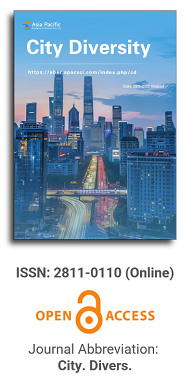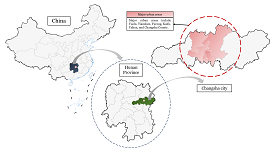
Asia Pacific Academy of Science Pte. Ltd. (APACSCI) specializes in international journal publishing. APACSCI adopts the open access publishing model and provides an important communication bridge for academic groups whose interest fields include engineering, technology, medicine, computer, mathematics, agriculture and forestry, and environment.

As China's pillar industry, the property market has suffered a considerable impact in recent years, with a decline in turnover and many developers at risk of bankruptcy. As one of the most concerned factors for stakeholders, housing prices need to be predicted more objectively and accurately to minimize decision-making errors by developers and consumers. Many prediction models in recent years have been unfriendly to consumers due to technical difficulties, high data demand, and varying factors affecting house prices in different regions. A uniform model across the country cannot capture local differences accurately, so this study compares and analyses the fitting effects of multiple machine learning models using February 2024 new building data in Changsha as an example, aiming to provide consumers with a simple and practical reference for prediction methods. The modeling exploration applies several regression techniques based on machine learning algorithms, such as Stepwise regression, Robust regression, Lasso regression, Ridge regression, Ordinary Least Squares (OLS) regression, Extreme Gradient Boosted regression (XGBoost), and Random Forest (RF) regression. These algorithms are used to construct forecasting models, and the best-performing model is selected by conducting a comparative analysis of the forecasting errors obtained between these models. The research found that machine learning is a practical approach to property price prediction, with least squares regression and Lasso regression providing relatively more convincing results.
Occupational diversity in Chinese cities: Facts, evolution and policy implications
Vol 5, Issue 1, 2024
Download PDF
Abstract
Measuring the occupational diversity and trend of Chinese cities from the perspective of the distribution of urban occupational types, and discussing the impact of urban characteristics on urban occupational diversity can provide reference for guiding urban full and high-quality employment. By using the improved Herfindahl index, panel data fixed effect model and Oaxaca blinder decomposition, it is found that the occupational diversity in Chinese cities showed a trend of first decreasing and then increasing from 2002 to 2016, which was due to the adjustment of urban industrial structure and the emergence of new economy after the financial crisis; at the same time, the larger the city, the higher the administrative level and the more developed the economy, the higher the degree of occupational diversity. The conclusion of the study is helpful to intuitively understand the occupational distribution, industrial structure and division of labor in different cities, evaluate the human resource structure and economic development potential of cities, and then provide policy suggestions for different cities to formulate industrial development and human resource planning.
Keywords
References
- Jacobs J. The Economy of Cities. 1969; 116-127.
- Duranton G, Puga D. Nursery cities: Urban diversity, process innovation, and the life cycle of products. American Economic Review. 2001; 91(2001): 1454-1477.
- Kemeny T, and Cooke A. Diversity and specialisation in cities: why, where and when does it matter? Urban Studies. 2000; 37(1999): 533-555.
- Xu X, Liu Y, Xiao Z. Dialect and economic growth. Journal of economics. 2015; 2.
- Zhang C. Foreign human capital, cultural diversity and urban innovation in China. World economy. 2019; 11.
- Xin H. Financial observation: urbanization stimulates China’s great economic potential. Available online: http://www.xinhuanet.com/finance/2019-04/29/c_1124432883.htm (accessed on 20 June 2024).
- Jacobs J. The Economy of Cities. 1969; 116-127.
- Quigley JM. Urban Diversity and Economic Growth. Journal of Economic Perspectives. 1998; 12(1998): 127-138.
- Rodgers A. Some aspects of industrial diversification in the United States. Economic Geography. 1957; 33(1957): 16-30.
- Malizia EE, Ke S. The influence of economic diversity on unemployment and stability. Journal of Regional Science. 1993; 33(1993): 221-235.
- Ottaviano G, and Peri G. The economic value of cultural diversity: evidence from US cities. Journal of Economic Geography. 2006; 6(2006): 9.
- Suedekum J, Wolf K, Blien U. Cultural diversity and local labour market. Regional Studies. 2014; 48(2014): 173-191.
- Trax M, Brunow S, Suedekum J. Cultural diversity and plant-level productivity. Regional Science and Urban Economics. 2015 53(2015): 85-96.
- Hu A, Wang W, Zhou S. Luyufeng: China creates a “new economy”—from narrowing the “digital divide” to reaping “digital dividends”. Journal of the National Academy of administration. 2016; 3.
- Wang W. Does industrial intelligence promote high-quality employment in the digital economy era. Economist. 2020; 4.
- Wu Y. The dual path model of labor market segmentation, occupational mobility and economic status acquisition of urban workers. China Social Sciences. 2011; 1.
- Brewer HL, Moomaw R. A Note on Population Size, Industrial Diversification, and Regional Economic Instability. Urban Studies. 1985; 22(1985): 349-354.
- Li R. Analysis of job mobility in Guangdong. Sociological research. 1997; 3.
- Quigley JM. Urban Diversity and Economic Growth. Journal of Economic Perspectives. 1998; 12(1998): 127-138.
- Duranton G, and Puga D. Nursery cities: Urban diversity, process innovation, and the life cycle of products. American Economic Review. 2001; 91(2001): 1454-1477.
- Mills ES. An Aggregate Model of Resource Allocation in a Metropolitan Area. American Economic Review. 1967; 57(1967): 197-210.
- Quigley JM. Urban Diversity and Economic Growth. Journal of Economic Perspectives. 1998; 12(1998): 127-138.
- Combes PP, Duranton G, Gobillon L, et al. 2012; 80(2012): 2543-2594.
- Chen Q, Qian X, Li J. The mystery of productivity premium in big cities in China. Economic research. 2016; 51.
- Marshall JU. City size, economic diversity, and functional type: the Canadian case. Economic Geography. 1975; 51(1975): 37-49.
- Fu S, and Hong J. Testing urbanization economies in manufacturing industries: urban diversity or urban size? Journal of Regional Science. 2011; 51(2011): 585-603.
- Glaeser EL, Kallal HD, Scheinkman JA, et al. Growth in cities. Journal of Political Economy. 1992; 100(1992): 1126-1152.
- Jacobs J. The Economy of Cities. 1969; 116-127.
- Duncan B, and Vernon H. Urban evolution in the USA. Journal of Economic Geography. 2003; 3(2003): 343-372.
- Krugman P. First Nature, Second Nature, And Metropolitan Location. Journal of Regional Science. 1993; 33(1993): 129-144.
- Combes PP. Economic structure and local growth: France, 1984-1993. Journal of Urban Economics. 2000; 47(2000): 329-355.
- Duranton G, and Puga D. Nursery cities: Urban diversity, process innovation, and the life cycle of products. American Economic Review. 2001; 91(2001): 1454-1477.
- Henderson V, Kuncoro A, Turner M. Industrial development in cities. Journal of Political Economy. 1995; 103(1995), pp. 1067-1090.
- Helsley RW, and Strange WC. Matching and agglomeration economies in a system of cities. Regional Science and Urban Economics. 1990; 20(1990): 189-212.
- Acemoglu D. Technology, Unemployment and Efficiency. Working Papers. 1996; 41(1996): 525-533.
- Glaeser EL, Kallal HD, Scheinkman JA, et al. Growth in cities. Journal of Political Economy. 1992; 100(1992): 1126-1152.
- Malizia EE, and Ke S. The influence of economic diversity on unemployment and stability. Journal of Regional Science. 1993; 33(1993): 221-235.
- Alonso-Villar O. Urban agglomeration: Knowledge spillovers and product diversity. The Annals of Regional Science. 2002; 36(2002): 55-573.
- Kemeny T, and Cooke A. Spillovers from immigrant diversity in cities. Journal of Economic Geography. 2018; 18(2018): 213-245.
- Duranton G, and Puga D. Diversity and specialization in cities: why, where and when does it matter? Urban Studies. 1999; 37(1999): 533-555.
- Alesina A, Harnoss J, Rapoport H. Birthplace diversity and economic prosperity. Journal of Economic Growth. 2013; 21(2013): 101-138.
- Kemeny T, and Cooke A. Spillovers from immigrant diversity in cities. Journal of Economic Geography. 2018; 18(2018): 213-245.
- Tress RC. Unemployment and the Diversification of Industry. The Manchester School. 1938; 9(1938): 140-152.
- Wundt BD. Reevaluating alternative measures of industrial diversity as indicators of regional cyclical variations. Review of Regional Studies. 1992; 22(1992): 59-73.
- Mookherjee D, and Ray D. Inequality and markets: some implications of occupational diversity. American Economic Journal: Microeconomics. 2010; 2(2010): 38-76.
- Malizia EE, and Ke S. The influence of economic diversity on unemployment and stability. Journal of Regional Science. 1993; 33(1993): 221-235.
- Alesina A, Devleeschauwer A, Easterly W, et al. Fractionalization. Journal of Economic Growth. 2003; 8(2003): 155-194.
- Li R. Analysis of job mobility in Guangdong. Sociological research. 1997; 3.
- Guo F, Wang J, Wang F, et al. Measuring the development of China’s digital Inclusive Finance: index compilation and spatial characteristics. Economics (quarterly). 2020; 4.
- Wei X, Zhang P, Du Y. How robots reshape the urban labor market: from the perspective of immigration tasks. Economic trends. 2020; 10.
- Malizia EE, Ke S. The influence of economic diversity on unemployment and stability. Journal of Regional Science. 1993; 33(1993): 221-235.
- Xu X, Liu Y, Xiao Z. Dialect and economic growth. Journal of Economics. 2015; 2.
- Ma S, and Zhao W. Dialect diversity and income of floating population-Empirical Research Based on chfs. Economics (quarterly). 2019; 1.
- Combes PP, Démurger S, Li S. Migration externalities in Chinese cities. European Economic Review. 2015; 76(2015): 152-167.
Supporting Agencies
Copyright (c) 2024 chuanyong Zhang, qimeng Cai

This work is licensed under a Creative Commons Attribution 4.0 International License.

This site is licensed under a Creative Commons Attribution 4.0 International License (CC BY 4.0).

Prof. Mehmet Cetin
Kastamonu University,
Turkey
Polish Scientific Bibliography

